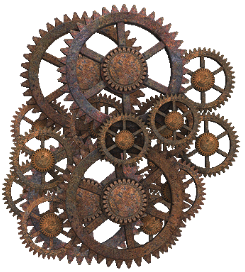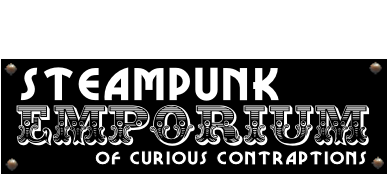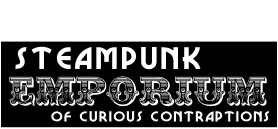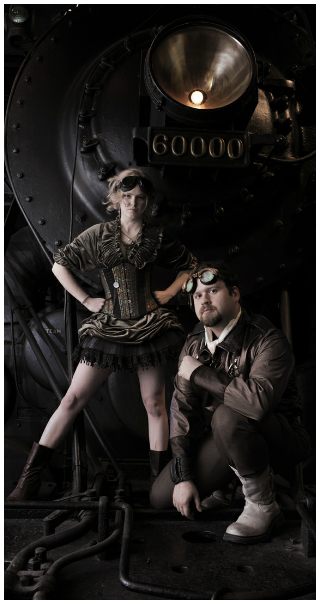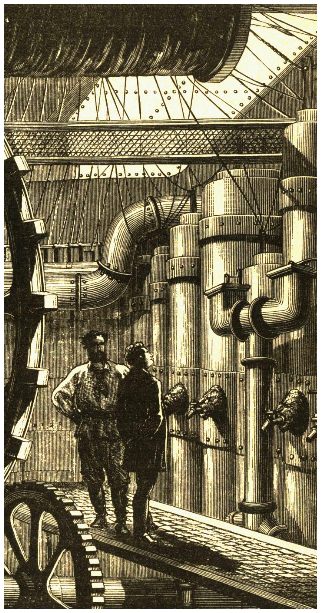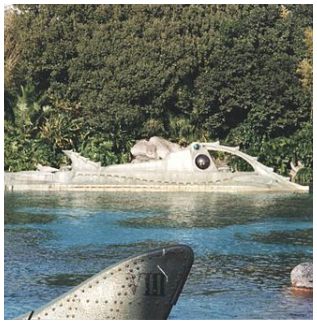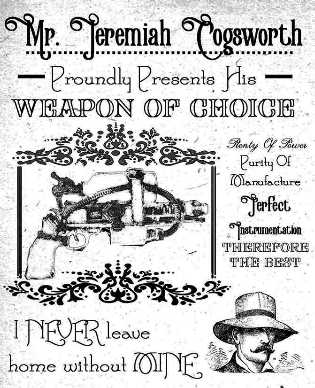Steampunk Styles and Settings
Since the 1990s, the application of the steampunk label has expanded beyond works set in recognisable historical periods, to works set in fantasy worlds that rely heavily on steam- or spring-powered technology. One of the earliest short stories relying on steam-powered flying machines is "The Aerial Burglar" of 1844. An example from juvenile fiction is The Edge Chronicles by Paul Stewart and Chris Riddell.
Fantasy steampunk settings abound in tabletop and computer role-playing games. Notable examples include Skies of Arcadia, Rise of Nations: Rise of Legends, and Arcanum: Of Steamworks and Magick Obscura.
The gnomes and goblins in World of Warcraft also have technological societies that could be described as steampunk as they are vastly ahead of the technologies of men, but are not magical like those of the Elves.
The Dwarves of the Elder Scrolls series, described therein as a race of Elves called the Dwemer, also use steam powered machinery, with gigantic brass like gears throughout their underground cities. However, magical means are used to keep ancient devices in motion despite the Dwemer's ancient disappearance.
The 1998 game Thief: The Dark Project as well as the other sequels including its 2014 reboot feature heavy steampunk-inspired architecture, setting and technology.
Amidst the historical and fantasy subgenres of steampunk is a type which takes place in a hypothetical future or a fantasy equivalent of our future, involving the domination of steampunk-style technology and aesthetics. Examples include Jean-Pierre Jeunet & Marc Caro's The City of Lost Children (1995), Turn A Gundam (1999–2000), Trigun and Disney's film Treasure Planet (2002). In 2011, musician Thomas Dolby heralded his return to music after a 20-year hiatus with an online steampunk alternate fantasy world called the Floating City, to promote his album, A Map of the Floating City.
American West Steam Punk
Another setting is "Western" steampunk, which overlaps with both the Weird West and Science fiction Western subgenres. Several other categories have arisen, sharing similar names, including dieselpunk, clockworkpunk, and others. Most of these terms were coined as supplements to the GURPS role playing game, and are not used in other contexts.
SteamPunk Fantasy and Horror
Kaja Foglio introduced the term "Gaslight Romance", gaslamp fantasy, which John Clute and John Grant define as "steampunk stories ... most commonly set in a romanticised, smoky, 19th-century London, as are Gaslight Romances. But the latter category focuses nostalgically on icons from the late years of that century and the early years of the 20th century--on Dracula, Jekyll and Hyde, Jack the Ripper, Sherlock Holmes and even Tarzan--and can normally be understood as combining supernatural fiction and recursive fantasy, though some gaslight romances can be read as fantasies of history." Author/artist James Richardson-Brown coined the term steamgoth to refer to steampunk expressions of fantasy and horror with a "darker" bent.
Post Apocalyptic SteamPunk
Mary Shelley's The Last Man, set near the end of the 21st century after a plague had brought down civilization, was probably the ancestor of post-apocalyptic steampunk literature. Post-apocalyptic steampunk is set in a world where some cataclysm has precipitated the fall of civilization and steam power once again gains ascendancy, such as in Hayao Miyazaki's post-apocalyptic anime Future Boy Conan (1978), where a war fought with superweapons has devastated the planet. Robert Brown's novel, The Wrath of Fate (as well as much of Abney Park's music) is set in A Victorianesque world where an apocalypse was set into motion by a time-traveling mishap. Cherie Priest's Boneshaker series is set in a world where a zombie apocalypse happened during the Civil War era. The Peshawar Lancers by S.M. Stirling is set in a post-apocalyptic future in which a meteor shower in 1878 caused the collapse of Industrialized civilization. The movie 9 (which might be better classified as "stitchpunk" but was largely influenced by steampunk) is also set in a post-apocalyptic world after a self-aware war machine ran amok. Steampunk Magazine even published a book called "A Steampunk's Guide to the Apocalypse", about how steampunks could survive should such a thing actually happen.
Victorian SteamPunk
In general, the category includes any recent science fiction that takes place in a recognizable historical period (sometimes an alternate history version of an actual historical period) in which the Industrial Revolution has already begun, but electricity is not yet widespread. It places an emphasis on steam- or spring-propelled gadgets. The most common historical steampunk settings are the Victorian and Edwardian eras, though some in this "Victorian steampunk" category can go as early as the beginning of the Industrial Revolution and as late as the end of World War I.
Some examples of this type include the novel The Difference Engine,the comic book series League of Extraordinary Gentlemen, the Disney animated film Atlantis: The Lost Empire, Scott Westerfeld's Leviathan trilogy, and the roleplaying game Space: 1889. The anime film Steamboy (2004) is another good example of Victorian steampunk, taking place in an alternate 1866 where steam technology is far more advanced than it ever was in real life. Some, such as the comic series Girl Genius, have their own unique times and places despite partaking heavily of the flavor of historic times and settings. Other comic series are of a more familiar London as in Victorian Undead which has Sherlock Holmes, Doctor Watson and others taking on zombies, Doctor Jekyll and Mister Hyde, and Count Dracula with some advanced weapons and devices.
Karel Zeman's film The Fabulous World of Jules Verne (1958) is a very early example of cinematic steampunk. Based on Jules Verne novels, Zeman's film imagines a past based on those novels which never was. Another early example of historical steampunk in cinema includes Hayao Miyazaki's anime films such as Laputa: Castle in the Sky (1986) and Howl's Moving Castle (2004), containing many archetypal anachronisms characteristic of the steampunk genre.
"Historical" steampunk usually leans more towards science fiction than fantasy, but a number of historical steampunk stories have incorporated magical elements as well. For example, Morlock Night, written by K. W. Jeter, revolves around an attempt by the wizard Merlin to raise King Arthur to save the Britain in 1892 from an invasion of Morlocks from the future.
Paul Guinan's Boilerplate, a 'biography' of a robot in the late 19th century, began as a website that garnered international press coverage when people began believing that Photoshop images of the robot with historic personages were real. The site was adapted into an illustrated hardbound book Boilerplate: History's Mechanical Marvel, and published by Abrams in October 2009. Because the story was not set in an alternative history, and in fact contained accurate information about the Victorian era, some booksellers referred to the tome as "historical steampunk."



